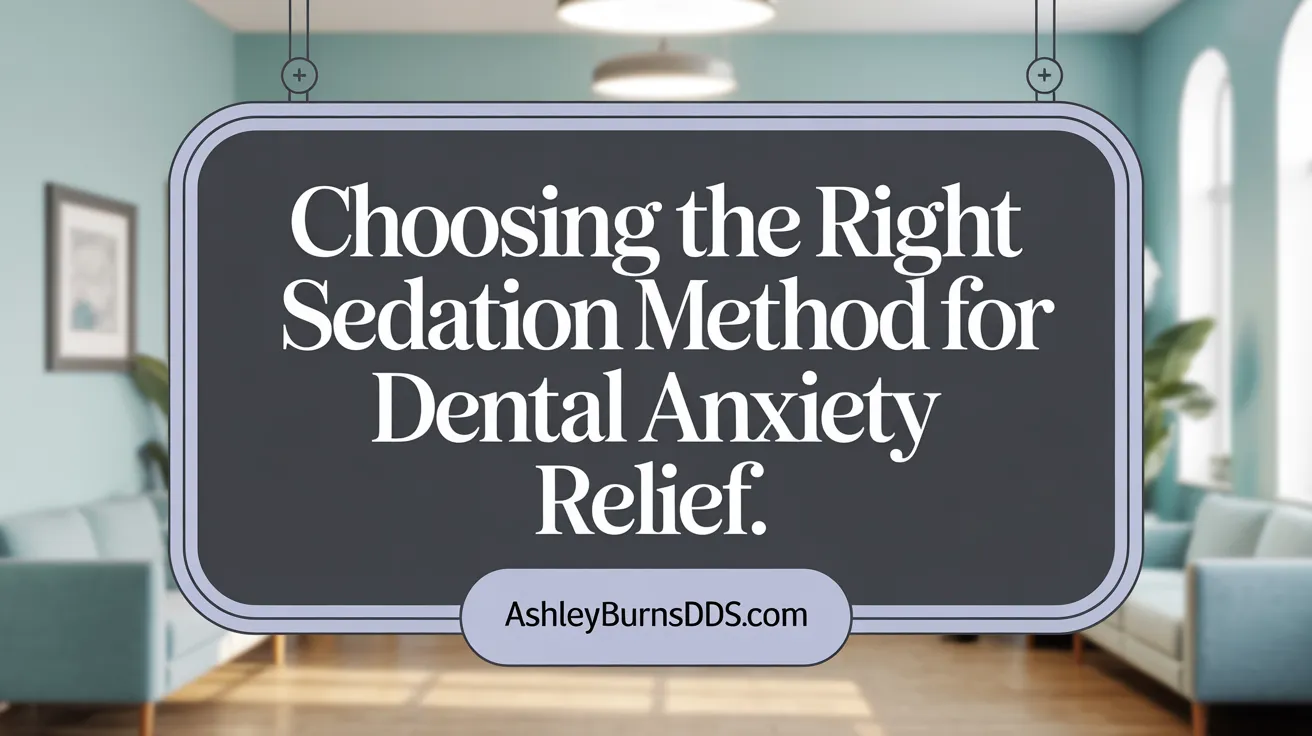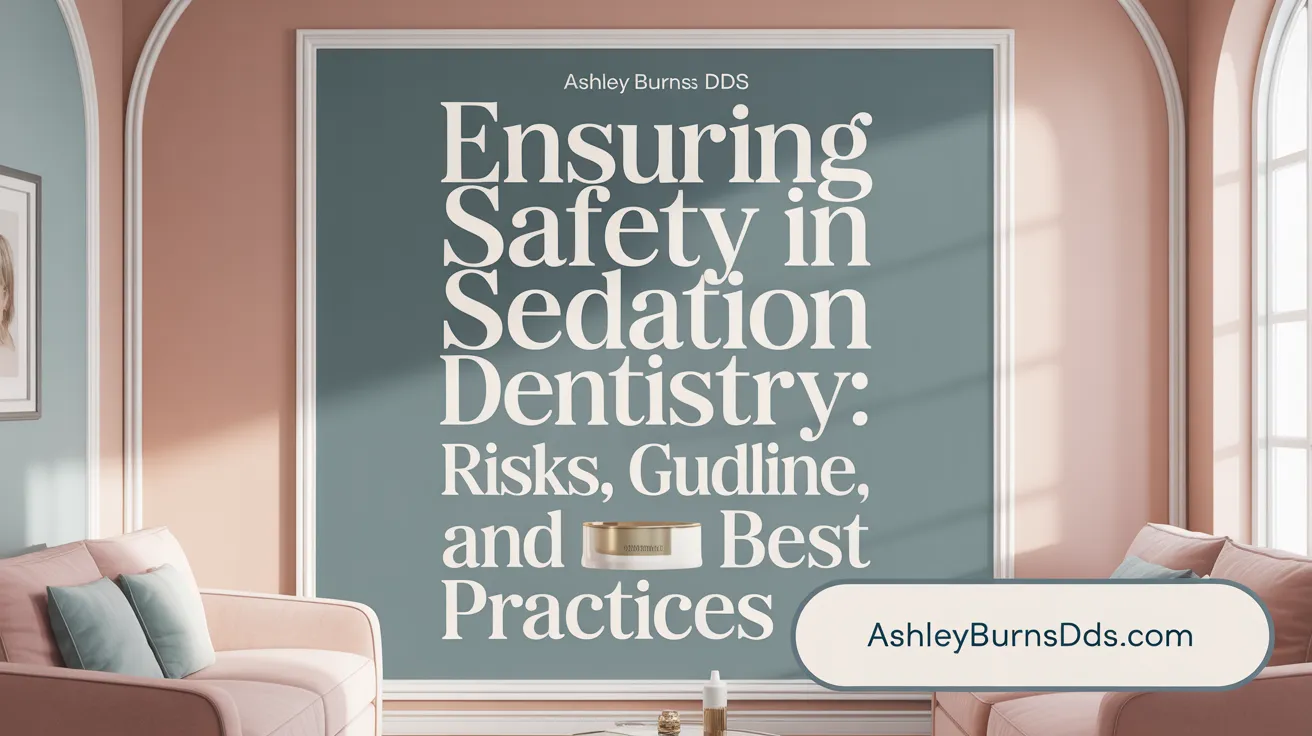Understanding Sedation Dentistry for Anxious Patients
Dental anxiety affects millions worldwide, often leading to avoidance of essential dental care. Sedation dentistry offers a range of options tailored to help nervous patients relax, ensuring comfort and cooperation during procedures. This article explores sedation methods, their administration, benefits, and safety considerations, empowering patients and dental professionals alike to improve the dental experience.
Common Sedation Methods and How They Work

Overview of Sedation Types
Sedation dentistry offers various options to help nervous dental patients relax during procedures. The most common methods include nitrous oxide sedation (laughing gas), oral conscious sedation, intravenous (IV) sedation, and, in some cases, general anesthesia. Each method provides different levels of relaxation, tailored to patient needs, medical history, and the complexity of the procedure.
Mechanism of Sedation Drugs
Sedation drugs work by depressing the central nervous system, reducing anxiety, pain perception, and sometimes inducing sleep. Nitrous oxide, inhaled through a mask, stimulates the release of natural painkillers called enkephalins and interacts with GABA receptors, leading to mild sedation. Benzodiazepines like midazolam enhance GABA activity, providing anxiolytic and amnesic effects. Agents like propofol induce deeper sedation or sleep when administered intravenously, controlling the depth precisely. In deep sedation or general anesthesia, drugs halt consciousness altogether, allowing extensive procedures. Details on these mechanisms are available in resources about conscious sedation in dentistry and current methods of sedation in dental patients.
Routes of Administration
Different pathways exist for delivering these medications:
- Inhalation: Nitrous oxide is inhaled via a nasal mask, with rapid onset and quick recovery.
- Oral: Medications such as diazepam or triazolam are taken in pill form, suitable for moderate sedation as discussed in oral sedation advantages and disadvantages.
- Intranasal: Drugs such as midazolam or ketamine are delivered through nasal sprays or drops, useful when injections are not preferred (midazolam and ketamine sedation details).
- Intravenous (IV): Sedatives like midazolam or propofol are injected into the bloodstream, offering controlled, deeper sedation (IV sedation techniques).
- Transmucosal: Medications can also be absorbed through the oral mucous membranes. Proper administration requires trained personnel, appropriate monitoring equipment, and emergency preparedness to ensure patient safety (ADA sedation and anesthesia administration guidelines).
Levels of Sedation
Sedation levels vary from mild to deep:
- Minimal (Anxiolysis): Patients are relaxed but fully responsive, achieved with nitrous oxide.
- Moderate (Conscious Sedation): Patients are awake but comfortable, often with oral or IV sedation (sedation levels explained).
- Deep Sedation: Patients are on the verge of unconsciousness but can be awakened with stimuli, usually via IV drugs.
- General Anesthesia: Complete unconsciousness, used for extensive surgery, typically in hospital settings (general anesthesia in dental care). Each level offers benefits depending on the patient's anxiety, health, and procedure complexity, always administered under professional supervision to maintain safety (sedation dentistry safety and monitoring).
Benefits and Suitability of Sedation Techniques for Dental Anxiety

How can sedation improve patient experience and comfort during dental procedures?
Sedation enhances patient experience by significantly reducing anxiety, fear, and stress associated with dental visits. It helps patients remain calm, relaxed, and sometimes even sleep through treatments, making complex or lengthy procedures more manageable. Sedation also minimizes discomfort caused by sights, sounds, and sensations in the dental environment, contributing to a less traumatic experience. This increased relaxation and cooperation result in more efficient treatment sessions, reducing the need for multiple visits and improving overall oral health outcomes. Importantly, sedation techniques allow individuals with high gag reflexes or dental phobia to undergo necessary treatments they might otherwise avoid. For a comprehensive sedation dentistry overview, including benefits and methods, see this resource.
What are the benefits and suitability of different sedation methods for managing dental anxiety?
Various sedation options cater to different levels of dental anxiety and procedure types. Nitrous oxide or laughing gas offers rapid onset and quick recovery, making it ideal for mild anxiety and short procedures, with patients able to drive afterward. Oral sedation involves pre-procedure pills and provides a deeper relaxation suitable for moderate anxiety and longer treatments, inducing sleepiness and reducing stress. IV sedation delivers deep, controlled sedation for severe anxiety or complex surgeries, allowing patients to remain comfortable and sometimes unconscious, with the added benefit of adjustable sedation levels. These methods are selected based on individual patient health, the complexity of the procedure, and specific needs, ensuring safety and maximizing comfort. When administered by trained professionals, they significantly improve the dental experience while reducing the psychological burden of treatment. For detailed comparisons of sedation types and safety considerations, see this guide and sedation dentistry safety info.
How do sedation options differ for specific patient populations such as children?
In pediatric dentistry, sedation options like nitrous oxide and mild oral sedation are commonly used because of their safety, ease of administration, and quick recovery times. These methods help children relax and stay calm during dental procedures without significant risks. Nitrous oxide is especially popular for young patients due to its rapid onset and minimal side effects, allowing children to remain responsive and able to breathe independently. Oral sedatives, administered in child-specific formulations, help extend relaxation during longer or more invasive treatments. For older children or those with special medical considerations, deeper sedation like IV sedation may be employed under careful supervision. Overall, sedation in children is tailored to age, weight, medical history, and procedure type, ensuring a safe, stress-free experience that encourages positive attitudes towards dental care. Learn more about pediatric sedation strategies and sedation safety in children.
Safety, Risks, and Professional Guidelines in Sedation Dentistry

What safety considerations, risks, and contraindications should be accounted for in dental sedation?
When considering dental sedation, a thorough review of the patient's medical history, allergies, and current medications is essential. This helps identify potential contraindications such as severe respiratory or cardiac conditions, pregnancy, or allergy risks. Different sedation methods like nitrous oxide sedation, oral conscious sedation, and IV sedation carry specific risks including respiratory depression, allergic reactions, nausea, dry mouth, and excessive drowsiness. Proper patient monitoring and adherence to safety protocols are vital to minimize these risks.
Patients should be informed about preparation requirements, such as fasting or medication adjustments, and the necessity of arranging transportation afterward. Special populations such as children, pregnant women, or those with underlying health issues require additional precautions and medical consultation prior to sedation.
Overall, when administered by qualified professionals following established safety guidelines, dental sedation is considered safe. Continuous evaluation and risk management are crucial to ensure patient safety during all procedures. For more details, see Risks and Safety in Sedation Dentistry.
What guidelines and safety measures exist for administering dental sedation?
Professional organizations like the American Dental Association (ADA provide comprehensive guidelines for safe sedation practices. These guidelines specify the necessary patient evaluation processes, including health history and physical assessment, as well as the certification requirements for practitioners, such as Basic Life Support (BLS) and Advanced Cardiac Life Support (ACLS).
Safety measures include the continuous monitoring of vital signs—such as oxygen saturation, blood pressure, heart rate, and respiration—throughout the procedure. Emergency equipment, including oxygen supply, resuscitation drugs, and airway management tools, must be readily available.
Patients should undergo pre-procedure assessments, which involve fasting, obtaining informed consent, and planning sedation levels suited to individual health status. Post-procedure monitoring ensures safe recovery and timely detection of any adverse effects.
Adherence to these standards significantly reduces the risk of complications and enhances the safety profile of sedation dentistry. You can learn more about Sedation Dentistry Safety and Guidelines.
What should dental professionals know about sedation management and patient care?
Dental professionals must be well-trained in sedation pharmacology, patient assessment, and emergency management. This includes evaluating patient health, selecting appropriate sedation levels, and understanding contraindications.
They should be proficient in operating monitoring equipment, managing airway safety, and responding swiftly to emergencies. Regular continuing education and certification renewal are necessary to stay current with evolving safety standards.
Proper documentation of sedation procedures, vigilant intra-procedural monitoring, and post-procedure care are critical components of responsible practice. Maintaining a safe environment involves preparedness for complications like oversedation, airway compromise, or allergic reactions.
In summary, comprehensive knowledge and strict adherence to safety protocols ensure that sedation dentistry can be administered effectively and safely, protecting patient well-being at all stages of care. For a detailed review, see Sedation Dentistry Management and Patient Care.
Managing Dental Anxiety: Sedation and Non-Pharmacological Strategies

What techniques can help calm nervous or anxious dental patients aside from sedation?
Several approaches can effectively calm anxious or fearful dental patients without resorting to sedation. Behavioral techniques like tell-show-do, where the dentist explains procedures in simple terms and demonstrates actions beforehand, help reduce uncertainty and foster trust. Positive reinforcement, praise, and modeling can encourage cooperation, especially in children.
Relaxation methods such as diaphragmatic breathing, progressive muscle relaxation, and guided imagery can induce a physical state of calm and reduce physiological symptoms of anxiety. Hypnosis and biofeedback are additional psychological techniques that promote relaxation. Distraction plays a significant role—music therapy, audiovisual displays, virtual reality environments, and aromatherapy are proven to divert attention away from dental procedures. Music, in particular, can greatly alleviate stress by creating a calming atmosphere.
Creating a soothing environment with calming decor, natural light, and a noise-free setting also contributes to reducing patient anxiety. Open communication about fears, offering patients control through signals to pause treatment, and ensuring a friendly, empathetic attitude by dental staff are vital components of a calming strategy (Managing Dental Anxiety).
How is dental anxiety and phobia managed through sedation and non-pharmacological methods?
Managing dental anxiety and phobia often requires a combination of pharmacological and non-drug techniques to optimize patient comfort and cooperation. Pharmacological methods such as inhalation sedation with nitrous oxide, oral benzodiazepines, IV sedation, and, in extreme cases, general anesthesia, provide rapid anxiety relief and enable complex or invasive procedures to be performed safely.
Non-pharmacological strategies encompass psychological therapies like cognitive-behavioral therapy, systematic desensitization, and hypnosis, which aim to address underlying fears and improve long-term coping skills. These approaches help reduce avoidance behaviors and promote regular dental visits.
Complementary methods such as music therapy, virtual reality distraction, aromatherapy, auricular acupuncture, and relaxed communication techniques can further reduce stress levels.
Tailoring these interventions according to the severity of anxiety, patient’s health status, and individual preferences ensures better outcomes. Combining sedation with behavioral techniques often results in more positive dental experiences, increased compliance, and healthier oral habits, ultimately reducing overall dental fear and enabling ongoing oral health care (Sedation Dentistry Overview.
Sedation Dentistry Procedures and Post-Care Protocols
What procedures and protocols are involved in sedation dentistry?
Sedation dentistry involves a series of careful procedures and protocols aimed at ensuring patient safety while effectively managing sedation levels. Before the procedure, patients undergo thorough evaluations, including medical history reviews, assessment of the airway, and sometimes lab tests, to determine their suitability for sedation. Informed consent is always obtained after explaining the risks and benefits. Learn more about the sedation dentistry overview and patient evaluation for sedation.
During the procedure, clinicians follow strict guidelines that include preparing the necessary monitoring equipment and emergency drugs. Continuous monitoring of vital signs such as oxygen levels, breathing, heart rate, and blood pressure is vital, especially during moderate and deep sedation, or anesthesia. The use of appropriate monitoring devices like pulse oximeters and ECG ensures early detection of any adverse events. For detailed monitoring and safety practices, see monitoring during sedation and emergency management in dental sedation.
Post-procedure, practitioners monitor patients until the sedative effects diminish, observing for signs of distress or side effects. This protocol helps confirm that the patient’s vital signs are stable and they have regained full consciousness before discharge. Read about post-procedure recovery from sedation and sedation recovery times.
Adherence to certified training standards and emergency protocols is essential to optimize safety throughout all stages—from pre-treatment assessment to post-sedation care—whether using nitrous oxide, oral medications, IV sedation, or general anesthesia. Proper documentation, staff trained in airway management, and readiness for emergencies are integral components of these protocols. For more on training and safety, see ADA sedation and anesthesia guidelines and statement on sedation and anesthesia administration.
What post-sedation safety guidelines, care instructions, and potential side effects should patients be aware of?
After sedation procedures, patients should remain under supervision until the effects have fully worn off. It is recommended that a responsible adult stays with them to monitor breathing, responsiveness, and comfort, and to ensure safe transportation home. Patients are advised not to drive, operate machinery, or handle important decisions for at least 24 hours post-sedation due to residual effects. Find more on post-sedation safety monitoring and sedation discharge procedures.
Common side effects include drowsiness, dry mouth, dizziness, headaches, nausea, and mild disorientation. These symptoms usually resolve within a few hours to a day. To aid recovery, patients should stay well-hydrated, rest adequately, and eat light, non-irritating foods. For detailed side effect information, see side effects of sedation medications and risks and side effects of sedation.
They should avoid alcohol, hot beverages, and strenuous activities during recovery. It is crucial to follow specific instructions provided by the dentist, such as oral hygiene and observing for any unusual symptoms. For guidance on post-procedure care, visit post-sedation care instructions.
If symptoms like severe pain, prolonged dizziness, difficulty breathing, or allergic reactions occur, immediate medical attention should be sought. Monitoring and proper post-care significantly reduce the risk of complications and ensure a safe return to daily activities. Review when to seek emergency dental care post-sedation and emergency signs after dental sedation for more information.
Enhancing Dental Care Through Tailored Sedation
Sedation dentistry represents a vital tool in improving the dental experience for nervous patients by offering tailored options that ease anxiety and facilitate necessary treatment. Understanding the types of sedation, their administration, benefits, and inherent risks allows patients and dental professionals to make informed choices prioritizing safety and comfort. Combined with non-pharmacological strategies, sedation dentistry fosters a collaborative and compassionate environment, transforming dental visits from stressful events into manageable and positive experiences. Ongoing adherence to rigorous professional standards and personalized care ensures that sedation remains a safe and effective approach to overcoming dental fear and enhancing oral health outcomes.
